
Grutas de Calcehtok
- Journey to the Center of the Earth: Exploring Grutas de Calcehtok
- Unraveling the Mayan Secrets: Grutas de Calcehtok
- Stalactites, Stalagmites, and a Symphony of Stone
- A Thrilling Descent into Darkness: Cave Exploration
- A Glimpse into the Maya Underworld: Xibalba
- Beyond the Caves: A Trip to Grutas de Calcehtok
- In the Company of Bats: Exploring the Cave's Ecosystem
- Safety First: Tips for a Safe Cave Adventure
- The Cave's Living Canvas: Flora and Fauna
- Unveiling the Mysteries: Archaeological Discoveries
- A Photographer's Paradise: Capturing the Cave's Beauty
- Local Legends and Folklore: The Caves' Enchantment
- Respecting the Sacred: Cultural Significance of the Caves
- Exploring Beyond Calcehtok: Other Caves in the Region
- Insider Tip: Unveiling the Secret Cave Entrance
Journey to the Center of the Earth: Exploring Grutas de Calcehtok
Grutas de Calcehtok, nestled in the heart of the Yucatán Peninsula, are a subterranean wonderland that invites travelers on a journey to the center of the earth. These caves, with their labyrinthine tunnels and otherworldly formations, have captured the imagination of explorers and archaeologists alike.
The caves hold immense historical significance, having served as a sanctuary for the ancient Maya civilization. Archaeological discoveries within the caves have shed light on Mayan rituals, ceremonies, and their deep connection to the caves, which they considered a portal to the underworld.
Geological forces have sculpted these caves over millions of years, creating a mesmerizing display of stalactites and stalagmites. The caves' intricate cave systems, adorned with stunning formations, offer a glimpse into the wonders of the natural world.
Unraveling the Mayan Secrets: Grutas de Calcehtok
Grutas de Calcehtok holds immense cultural significance for the Mayan people. These caves served as sacred sites for ancient Mayan rituals and ceremonies, connecting them to the spirit world. The Mayans believed that caves were portals to Xibalba, the underworld, and held deep spiritual importance. Archaeological discoveries within the caves have revealed evidence of these rituals, including ceramic artifacts, incense burners, and remnants of offerings left behind by the Maya. Cave paintings and petroglyphs adorn the walls, depicting Mayan symbols, deities, and scenes from their mythology. These artistic expressions provide valuable insights into Mayan cosmology, beliefs, and their intricate relationship with the natural world. Exploring Grutas de Calcehtok is a journey through time, allowing visitors to glimpse into the rich cultural heritage of the ancient Maya and their profound connection to the caves.
Stalactites, Stalagmites, and a Symphony of Stone
Calcehtok's caves are a testament to the wonders of nature, adorned with an array of stalactites and stalagmites that create a symphony of stone. Stalactites, formed by the slow dripping of water from the cave ceiling, hang like delicate chandeliers, while stalagmites rise from the cave floor like majestic pillars. The interplay of these formations gives the caves an ethereal quality, as if one has stepped into a subterranean cathedral.
The colors and textures of the cave walls add to their allure. The calcite deposits that form the cave formations come in a variety of hues, from creamy white to deep amber. The walls themselves are often covered in intricate patterns, created by the flow of water over millions of years. These patterns resemble abstract paintings, adding an artistic dimension to the caves.
The acoustics of the caves are another remarkable feature. The high ceilings and smooth walls create a natural amphitheater, amplifying even the slightest sound. A whisper can echo through the caves, creating an eerie and otherworldly atmosphere. This acoustic phenomenon has led to the caves being used for concerts and sound installations, transforming them into underground concert halls.
A Thrilling Descent into Darkness: Cave Exploration
Venturing into the depths of the Grutas de Calcehtok is an experience that blends adventure, wonder, and a touch of trepidation. Whether you're a novice spelunker or a seasoned caver, exploring these caves offers a unique and thrilling journey into the heart of the earth.
Safety is paramount during cave exploration, and guided tours are highly recommended for first-timers. Experienced guides provide essential safety briefings, ensuring you're equipped with the necessary gear, including helmets, headlamps, and appropriate footwear. They'll lead you through the intricate cave systems, pointing out hidden chambers, subterranean rivers, and awe-inspiring rock formations.
As you delve deeper into the caves, the darkness envelops you, creating an eerie yet exhilarating atmosphere. The only sounds are the gentle dripping of water, the echo of your footsteps, and the occasional rustle of wildlife. Your senses heighten as you navigate through narrow passages, crawl through tight squeezes, and descend into vast chambers that seem to stretch endlessly.
For experienced cavers seeking a more challenging adventure, independent exploration is an option. However, it requires extensive knowledge of cave systems, proper safety equipment, and a keen sense of direction. Regardless of your level of experience, exploring the Grutas de Calcehtok is an adventure that will leave you with unforgettable memories and a newfound appreciation for the wonders that lie beneath the earth's surface.
A Glimpse into the Maya Underworld: Xibalba
For the ancient Maya, caves were not merely geological formations but portals to the underworld, known as Xibalba. According to Mayan mythology, Xibalba was a dark and dangerous realm inhabited by powerful deities and monstrous creatures. Caves were seen as gateways to this subterranean world, where the Maya believed important rituals and ceremonies took place.
The Maya creation myth, the Popol Vuh, narrates the journey of the hero twins, Hunahpu and Xbalanque, into Xibalba to challenge the Lords of Death. The twins encountered various trials and obstacles in the underworld, including treacherous rivers, thorny paths, and encounters with jaguars and other fearsome creatures. Their successful navigation of these challenges symbolized the triumph of life over death and the renewal of the world.
Caves held deep symbolic significance for the Maya. They represented the womb of the earth, the place where life originated and where the spirits of the dead returned. The darkness and mystery of the caves mirrored the unknown and unpredictable nature of the underworld. Modern-day Maya communities still perform rituals and ceremonies in caves, seeking guidance and protection from the spirits that reside there.
Beyond the Caves: A Trip to Grutas de Calcehtok
Location and accessibility: The Grutas de Calcehtok are located in the municipality of Dzan, approximately 90 kilometers (56 miles) southwest of Mérida. The caves are easily accessible by car, and there are several tour operators that offer guided tours from Mérida.
Transportation options from Mérida: There are several transportation options available for getting to the Grutas de Calcehtok from Mérida. You can rent a car and drive, which takes about two hours, or take a bus from Mérida to Dzan, and then take a taxi or colectivo (shared van) to the caves.
Nearby attractions and activities: In addition to the caves, there are several other attractions and activities in the area. You can visit the nearby town of Dzan, which is known for its colonial architecture and its Cenote Xlacah, a natural swimming pool. You can also visit the nearby ruins of Chichen Itza, one of the most famous Mayan cities.
Accommodation and dining options: There are a few hotels and guesthouses in the area, as well as several restaurants. You can also find camping facilities at the nearby Cenote Xlacah.
In the Company of Bats: Exploring the Cave's Ecosystem
Beyond the awe-inspiring geological formations, the Grutas de Calcehtok are home to a diverse array of bat species, contributing to the cave's rich ecosystem. These remarkable creatures play a crucial role in maintaining the delicate balance of the underground world.
The caves provide an ideal habitat for bats, offering shelter, darkness, and a stable temperature. In return, bats contribute to the ecosystem by consuming insects, helping to control populations and maintain biodiversity. Their guano, rich in nutrients, fertilizes the soil, supporting the growth of unique plant species adapted to the cave environment.
While exploring the caves, visitors may encounter these fascinating creatures hanging from the ceiling or flitting through the air. It is important to respect their presence and observe them quietly, avoiding any disturbance. Responsible wildlife observation guidelines help ensure the well-being of these important animals and preserve the natural harmony of the caves.
Conservation efforts are vital to protect the bat population and their habitat. Limiting human impact, minimizing light pollution, and maintaining a clean environment are crucial steps towards preserving the delicate ecosystem of the Grutas de Calcehtok.
By understanding and appreciating the role of bats in the cave's ecosystem, visitors can contribute to the conservation of these remarkable creatures and ensure the long-term health of the Grutas de Calcehtok.
Safety First: Tips for a Safe Cave Adventure
Venturing into the depths of the Grutas de Calcehtok demands a proactive approach to safety. Before embarking on your spelunking adventure, familiarize yourself with the essential safety guidelines and precautions. Guided tours led by experienced professionals are highly recommended, especially for first-time cavers. These guides are well-versed in the cave's terrain, potential hazards, and emergency procedures.
Appropriate attire plays a crucial role in ensuring your safety. Opt for comfortable, non-restrictive clothing that allows for freedom of movement. Sturdy, closed-toe shoes with good traction are a must to navigate the slippery cave surfaces. Avoid wearing loose clothing or jewelry that could get caught on cave formations.
Heed the instructions provided by your guide regarding the use of safety equipment. Helmets are mandatory to protect your head from falling debris or low-hanging rocks. Headlamps or flashlights are essential for illuminating the dark cave passages, and spare batteries are recommended to avoid being left in the dark.
Be mindful of your surroundings and maintain a safe distance from cave walls and formations. Avoid touching or disturbing any cave features, as they are delicate and irreplaceable. Stay on designated trails and avoid venturing into unexplored or restricted areas of the caves.
If you have any health conditions or concerns, consult with your doctor before embarking on a cave exploration. It's also advisable to inform your guide about any medical conditions or allergies you may have.
Remember, safety is paramount in any cave adventure. By following these guidelines and exercising caution, you can fully immerse yourself in the wonders of the Grutas de Calcehtok while ensuring a safe and enjoyable experience.
The Cave's Living Canvas: Flora and Fauna
Grutas de Calcehtok is not just a geological wonder but also a haven for diverse flora and fauna that have adapted to the unique cave environment. The caves provide a refuge for a variety of plant species that have evolved to thrive in the absence of sunlight. Specialized roots and leaves help them absorb nutrients from the moist cave walls, while some plants have developed unique photosynthetic mechanisms to utilize the limited light that filters into the caves.
The caves are also home to a variety of animals that have adapted to the subterranean world. Blind cave fish navigate the dark waters using their acute sense of hearing, while cave crickets and spiders have developed long, slender bodies to navigate the narrow cave passages. Bats are perhaps the most iconic inhabitants of the caves. Several species of bats, including the Yucatán myotis and the cave-dwelling fruit bat, roost in the caves, playing a crucial role in the ecosystem by controlling insect populations and dispersing seeds.
Preserving the delicate balance of the cave ecosystem is of utmost importance. Conservation efforts are in place to protect the caves and their inhabitants. Visitors are encouraged to follow responsible wildlife observation guidelines, such as maintaining a respectful distance from wildlife, avoiding sudden movements, and minimizing noise to minimize disturbance to the cave's delicate ecosystem.
Unveiling the Mysteries: Archaeological Discoveries
The Grutas de Calcehtok have yielded a treasure trove of archaeological artifacts that provide invaluable insights into the ancient Maya civilization. Through meticulous excavations, researchers have unearthed a wealth of pottery, tools, and other artifacts that shed light on the daily lives and cultural practices of the Maya. These discoveries have helped piece together the puzzle of Maya history and provide a glimpse into their complex society.
One of the most significant finds in the caves was a series of beautifully preserved ceramic vessels. These vessels, adorned with intricate designs and motifs, offer a glimpse into the artistic and cultural traditions of the Maya. They also provide valuable information about the trade and exchange networks that existed in the region.
In addition to pottery, archaeologists have also discovered a variety of tools and implements in the caves. These tools, made from bone, stone, and wood, provide insights into the technological prowess of the Maya. They also shed light on the various activities that took place in the caves, such as hunting, gathering, and ritual ceremonies.
The archaeological discoveries made in the Grutas de Calcehtok have played a crucial role in advancing our understanding of the Maya civilization. These findings have helped to illuminate the complex social, cultural, and economic aspects of Maya life and have contributed to our appreciation of their enduring legacy.
A Photographer's Paradise: Capturing the Cave's Beauty
Grutas de Calcehtok presents a captivating canvas for photography enthusiasts, offering a unique blend of darkness, light, and natural wonders. To capture the essence of these caves, photographers must embrace the challenge of low-light conditions and master techniques that showcase the scale, grandeur, and intricate details of the cave formations.
Begin by experimenting with long exposure photography to capture the ethereal glow of stalactites and stalagmites against the darkness of the caves. Use a tripod to ensure stability and prevent camera shake, allowing for extended exposures that capture the subtle movements and textures of the cave walls.
To convey the vastness of the caves, employ wide-angle lenses that exaggerate perspective and create a sense of immersion. Experiment with different vantage points and angles to capture unique compositions that highlight the towering cave ceilings and the intricate network of tunnels and chambers.
When photographing cave formations, focus on capturing their unique shapes and sizes, as well as the intricate details and textures that adorn their surfaces. Use natural light sources, such as the faint glow of headlamps or sunlight filtering through cave openings, to create dramatic shadows and highlights that accentuate the three-dimensionality of the formations.
Remember to respect the delicate ecosystem of the caves and minimize your impact on the environment. Avoid using flash photography, as it can disturb the bats and other wildlife that inhabit the caves. Instead, rely on natural light or artificial lights with red filters to reduce the impact on the cave's inhabitants.
With patience, skill, and a touch of creativity, you'll capture stunning photographs that convey the awe-inspiring beauty and mystery of Grutas de Calcehtok, creating lasting memories of your subterranean adventure.
Local Legends and Folklore: The Caves' Enchantment
Legends and folklore have always been an intricate part of the caves' allure. According to local Mayan legends, the caves were once the gateway to Xibalba, the Mayan underworld. It was said that brave warriors and priests would venture into the caves to communicate with the spirits of the deceased and seek guidance from the Mayan gods. These stories have been passed down through generations, adding to the mystical aura of the Grutas de Calcehtok.
In modern times, the caves continue to inspire stories and experiences. Visitors often recount tales of strange encounters, eerie sounds, and unexplained phenomena within the caves. Could these be echoes of the ancient Mayan rituals, or mere tricks of the imagination? Whatever the explanation, these stories add a touch of mystery and enchantment to the exploration of the caves.
Exploring the Grutas de Calcehtok is not just a journey into the depths of the earth; it's a journey into the heart of Mayan culture and folklore. Every twist and turn of the cave holds the potential for uncovering a new legend, a new story, or a new experience that will stay with you long after you leave the caves. So, embrace the mystery, let your imagination soar, and allow the caves to weave their magic on your soul.
Respecting the Sacred: Cultural Significance of the Caves
The Grutas de Calcehtok hold immense cultural significance for the Mayan people, who consider them sacred and imbued with spiritual power. As visitors, it is crucial to respect this cultural heritage and behave appropriately within the caves. This includes refraining from touching or damaging any cave formations, artifacts, or wildlife. It is also essential to avoid loud noises or disruptive behavior that may disturb the tranquility of the caves.
When visiting the caves, it is important to follow local customs and traditions. For example, it is customary to ask permission from the local Mayan community before entering the caves. Visitors should also be mindful of any ongoing ceremonies or rituals and avoid disrupting them. By respecting the cultural significance of the caves and behaving respectfully, visitors can help preserve this sacred site for future generations.
Exploring Beyond Calcehtok: Other Caves in the Region
While Grutas de Calcehtok holds a unique charm, the Yucatán Peninsula is home to a network of other captivating caves, each offering its own distinctive features and attractions. Cenote Xkeken, located near Valladolid, is renowned for its crystal-clear waters, where visitors can swim and snorkel amidst stalactites and stalagmites. Balankanché Cave, situated near Chichén Itzá, boasts impressive cave formations, ancient Mayan artifacts, and a cenote within its depths. For those seeking an adventurous spelunking experience, Sistema Sac Actun, the world's longest underwater cave system, offers a thrilling journey through subterranean rivers and chambers.
Planning a multi-cave exploration adventure is a fantastic way to delve deeper into the Yucatán's underground wonders. Start by researching the various caves in the region to identify those that align with your interests and abilities. Consider factors such as cave length, difficulty level, and accessibility. Guided tours are available for most caves, providing a safe and informative experience.
Pack appropriate gear for cave exploration, including sturdy shoes, comfortable clothing, and a headlamp. Be prepared for varying temperatures and humidity levels within the caves. If you plan to swim or snorkel in cenotes, bring a swimsuit and towel.
To make the most of your multi-cave adventure, consider hiring a local guide. They can lead you to hidden gems, share insights into the region's geology and history, and ensure your safety throughout the exploration.
Insider Tip: Unveiling the Secret Cave Entrance
Beyond the main entrance to Grutas de Calcehtok, a hidden gem awaits adventurous spelunkers. Ask a local guide about the secret cave entrance, a hidden path known only to a select few. The thrill of discovering this clandestine passage is unparalleled, as you venture into a lesser-known realm of the caves. Explore secret chambers and untouched formations, marveling at the wonders that lie beneath the surface. But remember, respect the sanctity of this hidden gem and tread lightly, leaving no trace behind.









